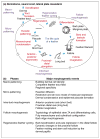Molecular signaling in feather morphogenesis
- PMID: 17049829
- PMCID: PMC4406286
- DOI: 10.1016/j.ceb.2006.10.009
Molecular signaling in feather morphogenesis
Abstract
The development and regeneration of feathers have gained much attention recently because of progress in the following areas. First, pattern formation. The exquisite spatial arrangement provides a simple model for decoding the rules of morphogenesis. Second, stem cell biology. In every molting, a few stem cells have to rebuild the entire epithelial organ, providing much to learn on how to regenerate an organ physiologically. Third, evolution and development ('Evo-Devo'). The discovery of feathered dinosaur fossils in China prompted enthusiastic inquiries about the origin and evolution of feathers. Progress has been made in elucidating feather morphogenesis in five successive phases: macro-patterning, micro-patterning, intra-bud morphogenesis, follicle morphogenesis and regenerative cycling.
Figures



References
-
- Sengel P. Morphogenesis of skin. In: Abercrombie M, Newth DR, Torrey JG, editors. Developmental and Cell Biology Series. Cambridge Univ. Press; Cambridge: 1976.
-
- Chuong CM. The making of a feather: homeoproteins, retinoids and adhesion molecules. Bioessays. 1993;15:513–521. - PubMed
-
- Prum RO. Development and evolutionary origin of feathers. J Exp Zool. 1999;285:291–306. - PubMed
-
- Dhouailly D, Olivera-Martinez I, Fliniaux I, Missier S, Viallet JP, Thelu J. Skin field formation: morphogenetic events. Int J Dev Biol. 2004;48:85–91. A rich reflection on experimental embryology studies of tract formation, and to bring them to modern biology. - PubMed
Publication types
MeSH terms
Grants and funding
LinkOut - more resources
Full Text Sources

